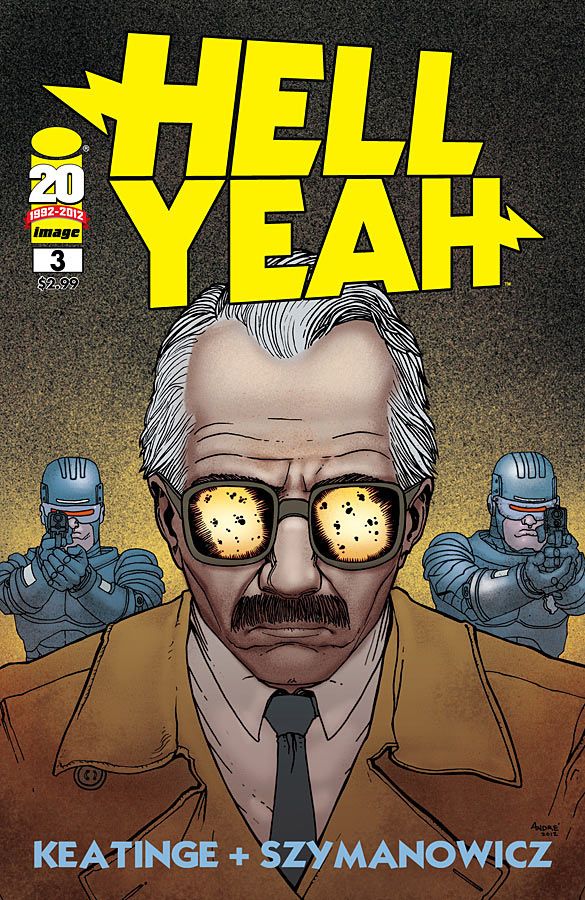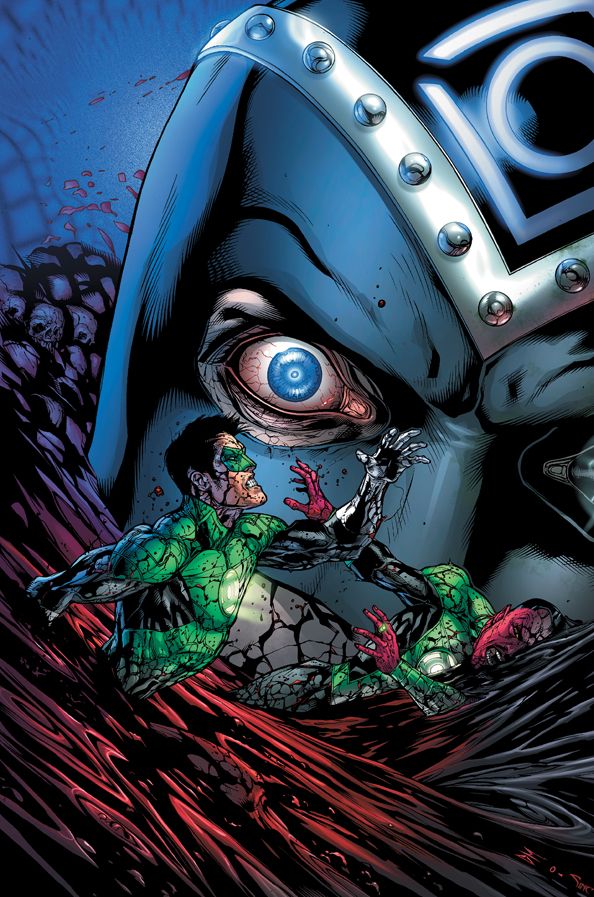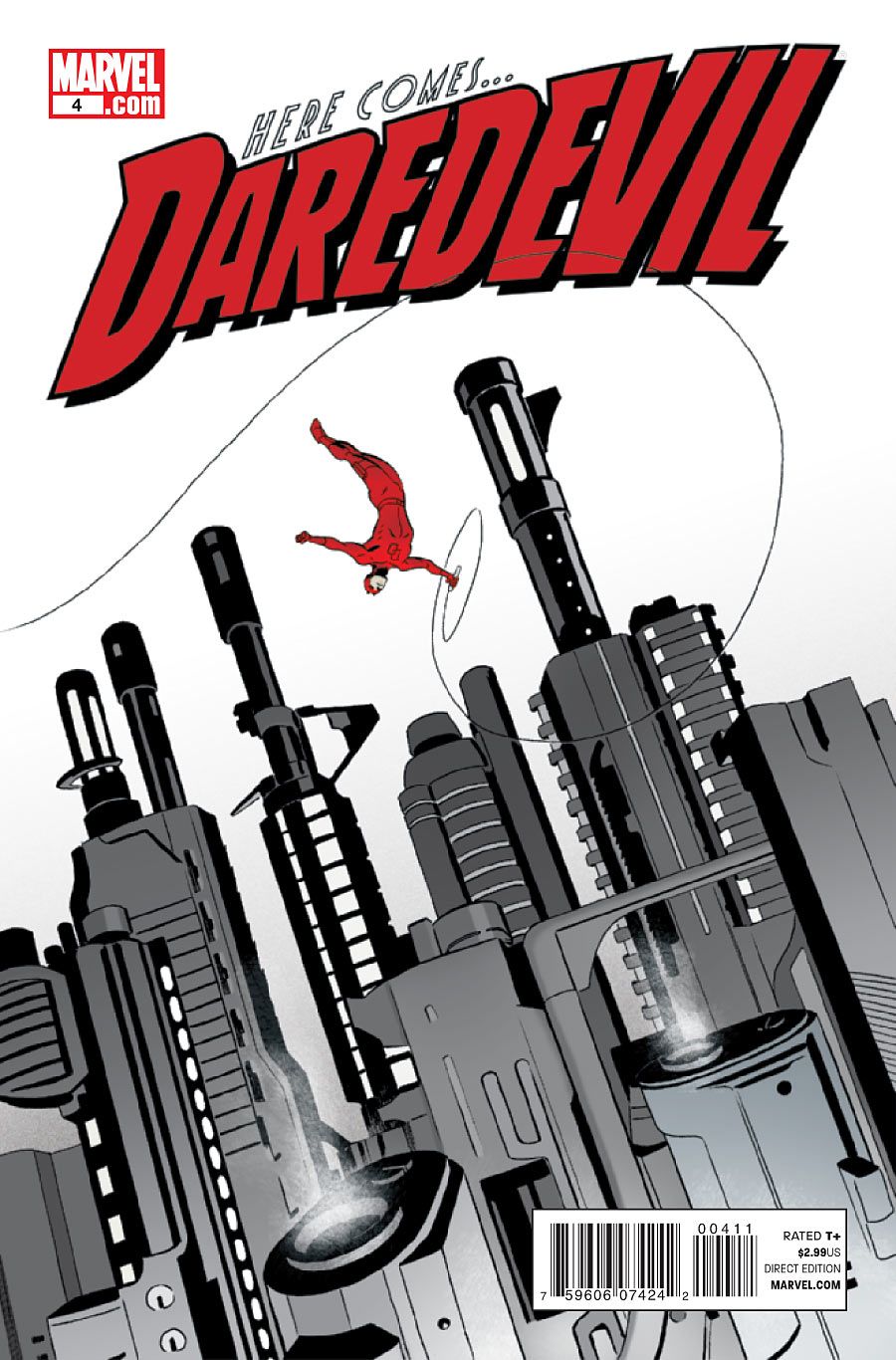Happy Mother's Day and welcome to another edition of What Are You Reading? Today our special guest is Ryan Ferrier, who I spoke to a couple of weeks ago about his comic Tiger Lawyer and recently kicked off an Indie GoGo project to fund the second issue.
To see what Ryan and the Robot 6 crew have been reading, click below.
*****
Michael May
It was Frankenstein week for me, starting with Steve Niles and Bernie Wrightson's Frankenstein Alive, Alive! #1. It's a compliment that I got to the end and was disappointed that there wasn't more. I thoroughly enjoyed not only seeing Wrightson draw the Monster again, but the range of emotions that Niles put into the story. I started the issue laughing as the Monster made references to the more popular movie version, but ended it reminded of the sadness that haunts him. They're also reprinting Mary Shelley's novel in serialized form in the back of each issue. That's an excellent idea.
I followed that by catching up on Jeff Lemire and Alberto Ponticelli's Frankenstein, Agent of SHADE. The last time I checked in, I thought the series was launching another long story (like the one that opened the series) featuring the rebellion of some SHADE underlings. I was not-unpleasantly surprised that that only took one issue to wrap up, letting Frank and Company move on to other (and - it turns out - better) things. Like Niles and Wrightson, Lemire and Ponticelli have a great handle on the pathos that defines their main character. Without spoiling anything, I'll just say that I'm sort of heart-broken for the guy; as I should be when reading a Frankenstein story. I'd be more heart-broken if this version didn't seem to bring some of his troubles on himself, but Lemire's obviously fooled me before and I imagine that there's a lot more to Frankenstein's decision-making than has so far been revealed.
Speaking of surprises, Ted Naifeh's Courtney Crumrin #2 certainly zigged when I expected it to zag. I thought the first issue had clearly set up the villain of the initial story, but the second issue flipped that over on me. It's really impressive that Naifeh's subverting expectations in such a dramatic way in only the second issue. That's an extremely promising way to start this series.
I also caught up with All-Star Western and have mixed feelings about it. Just as Jimmy Palmiotti and Justin Gray had me convinced that keeping Jonah Hex in Gotham would be kind of awesome, they moved him to New Orleans. I love New Orleans, so the change is mostly cosmetic, but that's kind of the problem. Nothing has really changed with the move. Hex and Arkham are still in a big city fighting a secret society of that city's most powerful citizens. Two other problems are a) that the social issues at stake are easily recognizable as some of the top issues of today and b) it's hard to believe that Hex let the doctor follow him to Louisiana. I suppose that letting Arkham tag along could be character development for Hex (is he starting to appreciate the doctor's company?), so I'm willing to go along with that. I'm just not thrilled that the social messages are so on the nose. Don't get me wrong, they're great messages; I just wish they were more subtle. Then again, subtlety isn't something Jonah Hex is known for as a character, so maybe I shouldn't expect it in his comic. Like I said, "mixed feelings." I'm not conflicted about the appearance of Nighthawk and Cinnamon in the current story though. This is my first introduction to those characters, but I already love them.
Finally, speaking of social issues, I'm caught up again with Planet of the Apes, and I'm glad I waited until the most recent issue to catch up. There was some rough going for an issue or two as the series got very on-the-nose with it's commentary about terrorism, including a set piece with a zeppelin crashing into a skyscraper. But we've moved past that now and are back to the character-driven storytelling that I love this series for. Daryl Gregory and Carlos Magno have created a wonderful ensemble cast that I look forward to visiting every month. And Gregory's writing is always bold. Even though that fearlessness doesn't always pay off, like with the 9/11 analog, most often, it does. For example, when the story skips ahead ten years in the middle of an issue and not only did I not mind, but it felt like the exact, perfect thing to do.
Tom Bondurant
Green Lantern #9 (written by Geoff Johns, pencilled by Doug Mahnke, inked by committee) was another solid installment in the Indigo Tribe origin-story arc. I won't spoil it for any latecomers, but apart from a revelation that puts the Indigos pretty close to a pair of very familiar GLs, I like the methodical approach Johns has to building up the various Lantern Corps. As it is with Aquaman, the less carnage it has, the easier it is to like a Johns-written book. At the same time, though, it gives Johns the space to do a slow burn, and the Indigos' story so far has been nicely creepy.
I got the new-edition Knightfall Volume 1 -- which is a monster of a paperback, the size of a Showcase Presents but in all its glorious Adrienne Roy colors -- so I thought I'd take in Batman: Vengeance of Bane, the book's opener. Written by the ubiquitous Chuck Dixon, pencilled by Graham Nolan, and inked by the late Eduardo Barreto, B:VOB remains as harrowing as it was twenty years ago. Bane wasn't the first "anti-Batman," but he's the best. His father was a revolutionary whose forces lost badly to the totalitarian government. It executed the father and imprisoned his mother (uh, Happy Mother's Day?) while she was pregnant with him, so he was born in a brutal Devil's Island-style prison. His ten years in solitary, vermin-infested confinement only made him stronger, and by the time he was released he'd trained his body and mind to ultra-fine points. Oh, and he'd also had a vision of destroying the bat-thing which represented his deepest fears. No wonder Christopher Nolan liked this guy. At this point augmenting his physique with a Venom-derived steroid was almost an afterthought. Anyway, he escapes by faking his death, then breaks his select group of henchmen out of prison in order to a) help one settle an old score in Gotham, and b) lay the groundwork for killing Batman and taking over the city.
By the way, three of "Knightfall's" artists later went on to work on soap-opera strips: Nolan on Rex Morgan, M.D., and Barreto and (succeeding him) Mike Manley on Judge Parker. It goes both ways, too -- Neal Adams got his start on Ben Casey. (And Joe Giella, who inked many "New Look" Batman stories in the '60s, still draws Mary Worth! How I'd love to see Norm Breyfogle take on Charterstone's crew....)
Finally, since I referenced it in Thursday's Grumpy Old Fan, I re-read the first Denny O'Neil/Neal Adams Batman story, January 1970's "The Secret Of The Waiting Graves!" from Detective Comics #395. It's a Gothic tale with an EC-type ending, set against the indigo hues of a Mexican garden party, but this time around I enjoyed the lengths to which Bruce Wayne went to investigate the shady doings at the Muertos' manor. The story opens with a gloomy image of Batman standing over two open graves (with no dates of death), but moves quickly to the Darknight Detective rescuing a random balloonist from killer falcons. They shred his balloon and send him tumbling, but Batman is able to leap into his path, knocking them both into a more forgiving water landing. Bruce then appears at the party, but he barely has time for small talk when the balloonist (who's also a party guest) starts dodging sniper fire -- so a hasty excuse and shed tuxedo later, Batman's back in action. Again, "SOTWG" is wonderfully moody and sets the tone well for O'Neil/Adams' collaboration, but today I'm just thinking about the logistics of "costume on, costume off! Costume on...."
Chris Mautner
Popeye Vol. 6: Me Li'l Swee' Pea -- This is the last of the real, "classic" Popeye volumes, meaning it's the last batch of Popeye comics E.C. Segar did before dying of leukemia in 1938. Underscoring the tragedy is the fact that Segar's skills hadn't dimmed at despite his illness. The final daily storyline, King Swee' Pea, is as strong and hilarious as Segar's best material, a fact that the dull, lifeless fill-in strips provided by assistant Doc Winner, who, despite his name, was anything but. This volume is also special as it contains one of the saddest sequences I've ever read in comics, wherein Swee' Pea is taken from a distraught Popeye. I wrote about it here, so I won't bore you with repetition, but I think it speaks to Segar's genius about how verklempt this sequence still makes me.
Krazy & Ignatz 1922-24: At Last My Drim of Life Has Come True -- This is the final volume in Fantagraphics' Krazy Kat collection, though for roundabout publishing reasons, it catches the strip midway through its run. Reading this latest collection, I feel like I have a deeper appreciation for Herriman's narration, which I always kind of saw as entertaining, but secondary to the dialogue and situations. I'm not sure why, but I feel like something "clicked" here and another piece of the Herriman puzzle has fallen into place for me. Another great thing about this book: A whole run of Herriman's "Us Husbands" strip as well as some really early stuff.
Brigid Alverson
I¹m all over the map this week. After hearing the news that Mike Baron and Steve Rude are reviving Nexus, I got the first volume of the Dark Horse Archives edition to check it out. The book includes the first seven issues, and the first three are in glorious black and white. Rude's art is surreal, smooth-lined and slick, with beautiful use of pure blacks and white, but his spatial sense is sometimes a little disorienting. The story, of a vigilante superhero who sees atrocities in his dreams and then goes out to avenge them, is original and engaging. The other books are kind of hard to find, but I'll be looking out for them.
On my way down to MoCCA, I read Hellbound #2, a black-and-white anthology of short horror comics by members of the Boston Comics Roundtable. The craftsmanship in this volume is impressive, especially given that none of the creators are full-time cartoonists. John Hilliard's "Eugene" is the story of a hairy, vampire-like monster stalking innocent victims, but the cheerful storytelling style makes it seem charming--right up until the surprise ending. Joshua D. Hoagland's "Mt. Auburn Night," set in the Cambridge cemetery, is a beautiful romp of skeletons and gravestone statuary, drawn with strong blacks and white in a style reminiscent of Aubrey Beardsley. Both are wordless stories (well, "Eugene" has one word balloon) that use strong visuals and creative panel layouts to pull the reader in and tell the story. I have to mention "Robmeblind.com," written by my MoCCA travel companion J.L. Bell and drawn by Andy Wong, a clever story about burglars who use the web to scout out potential victims.
I read a couple of this month's new Archie comics as well. The flagship Archie title is the second episode of the Archie Marries Valerie arc, and it is a marvel of compressed storytelling: In just 20 pages Archie and Valerie get engaged, get married, start experiencing problems because of their touring schedules with their respective bands and come up with a resolution to the problems (with help from Archie's scheming manager Alex). It's an amiable comic, but it feels a bit insubstantial--there are conflicts and drama, but everything gets resolved quickly. Betty and Veronica #259, on the other hand, offers four six-page stories and it feels more satisfying. None of the stories is earth-shaking, but they are more densely packed with action. This particular issue also offers an interesting contrast in inking styles, with three stories penciled by Stan Goldberg and inked by different artists. Bob Smith and Jim Amash have smooth styles that fit neatly into the Archie look, but Ken Selig's jagged-lined inking results in a completely different look.
Ryan Ferrier
First off, let me apologize if my picks seem slightly out of date; I’m way behind on my new comic reading. The leader of the stack, so to speak, is Mark Waid’s Daredevil, which I finally started, and while I’m about nine issues behind right now, this is by far my favorite book to come out of Marvel for quite some time. As a huge Daredevil fan, Waid breathes back life into a character I felt had become, for a lack of better words, a downer. Or perhaps Shadowland left a bad taste in my mouth. Nonetheless, the first three issues of Waid’s take on the man without fear are relished. It’s fun and bright and definitely old-school, and it’s great to see Murdock on the up and up. Daredevil’s one of those great characters that tells tragedy so well, but at the same time I feel like we all need a break from lying in the gutters, and this suits my newt. Mark Waid can pace the hell out of an issue, and quite frankly I’m amazed at the panel count he can manage in a twenty-two page book. I’d love to see a script for these early issues. While I haven’t made it to Marcos Martin or Chris Samnee’s pages yet, Paolo Rivera’s art is breathtaking. A contender for my favorite Daredevil art, period. I love how much focus is back on Matt’s abilities. To me, it’s like the character’s been around for almost 50 years, and his powers still intrigue me; I’ve never seen such a design-oriented approach to visualizing them. Reminds me why ol’ horn-head is my favorite character.
Next up is a book from someone I look up to greatly, the wonderfully talented writer (and accomplished letterer) Ed Brisson. That book is Murder Book vol. 3 (the third in his series, obviously). Ed’s Murder Book series are self-published crime mini-anthologies, and they are incredible. This issue features two stories, "Fathers & Sons" with art from Jason Copland, and "Midnight Walk" with art from Johnnie Christmas (best name ever?). Everything about this comic, this series, is exceptional, right down to the design of the book and the paper it’s printed on. Brisson has received great acclaim for his Murder Books, and honestly, in the age of the indie book uprising, and the palpable desire for less capes and cowls, Murder Book should be lining the top shelf of every comic shoppe in your city. Or maybe I’m just a sucker for hard-hitting doses of crime, murder, and tension. Jason Copland and Johnnie Christmas (still best name ever) nail their respective stories, both hitting that gritty black-and-white pulp feel home while bringing their own style and touch to the genre. Seek this out. Hunt it down. Buy it. Consume it. Also, though it goes without saying, the lettering in this book is the standard I hold to every comic book that enters my paws. Ed Brisson is simply the best, and I’ve already told him he can letter my tombstone when the time comes (he’s immortal, see, and will outlive us all).
Another indie book I read was Anathema from writer Rachel Deering and artist Chris Mooneyham. Like Murder Book, it’s incredibly refreshing to read a comic that is so clearly not only a passion piece, but an example of the talent and standard that indie comics can and should be. Deering is all about horror, but Anathema--which deals with the occult and werewolfism--isn’t exploitative or contrived, something that plagues every genre, especially the things that go bump in the night. On the contrary, Anathema is completely respectful of its genre while at the same time Deering shows her command of horror with a script tighter than a noose (forgive me, it’s late and I begin to turn into Gene Shalit when I’m fed after midnight). The wonderful thing about Anathema is how it incorporates multiple elements, mythos and iconographies of horror. It’s got witches, werewolves and super creepy panels with bats and crows and spindly little fingers, but it never seems out of place or forced in. That’s why I call this book a passion project, it’s very clear that this is a book the creators had to make. It’s entirely refreshing. Chris Mooneyham’s art is gorgeous. His page layouts are awesome and inspired, and he gets such great expression out of his characters. Fares Maese’s colors are really great too, and definitely need to be noted. All around just a fantastic first issue.
Lastly, I’d be nuts not to mention Hell Yeah #3, and I’m not including this out of a sense of obligation. This really is a great issue, each one building on the last. Joe Keatinge is having fun, I can tell, and when I read Hell Yeah I get a sense of that giddy feeling I’m sure he had. That creative catharsis. The grin I’m imagining as the last page was scripted. I love the direction this issue took, especially in one particular “jaw-dropping” panel. Most of all, I like how Hell Yeah is different. And the first "Baby Girl" back-up started in this issue, and it is equal parts amazing and beautiful and action-packed and awesome.
That does it for me, really, but I’m also slowly making my way through Planetary for the second time (I now have the entire omnibus on my iPad), and I think I’ll continue to do that forever.






